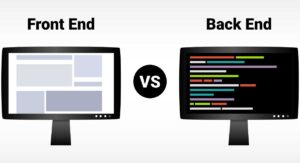Businesses that want to succeed in the software/application market must release products that are as free from errors as possible while smoothly functioning as advertised. Developers use software testing to ensure that these goals are met. However, the testing is only as effective as the tools used, so choosing the right tools for the job is essential.
This article showcases the ten best software tools available today. We’ll define the term, explain the different types of testing tools, what you should consider before choosing the ideal testing tool, the advantages of testing tools, and how you can train online through an online web development bootcamp.
So, what are software testing tools, anyway? First, let’s explain software testing.
What is Software Testing?
Software testing involves comparing the application to its user and system requirements. Testing can be accomplished at the program code’s phase or module level in the software development life cycle (SDLC). Both verification and validation are software testing components.
What are Software Testing Tools?
Unsurprisingly, software testing tools are applications used to test and verify software to improve the application and quality assurance. They support test analysis, defect logging, and test execution.
Software testing tools ensure developers that any software still in development meets the project’s objectives. Testing tools in software testing can also verify a product’s reliability and security.
Also Read: A Guide to Software Engineer Interview Questions
Types of Software Testing Tools
Software testing is divided into two types: static and dynamic. These terms are also used to split software testing tools into two categories:
Static Test Tools
Static test tools work on static testing processes. These tools don’t test the software’s actual operation. Static test tools consist of:
- Flow analyzers. Flow analyzers provide data flow flexibility from input to output.
- Path tests. These tests find unused and inconsistent code.
- Coverage analyzers. Coverage analyzers test all rationale paths.
- Interface Analyzers. Interface analyzers check the results of passing variables and module data.
Dynamic Test Tools
Dynamic test tools test the software with current, existing data. Dynamic test tools include:
- Test drivers. A test driver provides input data to a module-under-test (MUT).
- Test beds. Test beds simultaneously display the source code and the executing program.
- Emulators. Emulators provide the response facilities used to imitate undeveloped parts of the system.
- Mutation analyzers. Mutation analyzers test the system’s fault tolerance by deliberately placing errors in the software’s code.
Factors to Bear in Mind When Choosing a Software Testing Tool
Consider the following things when selecting the ideal software testing tool.
- Cost. Cost, budget, and end-user requirements are the most critical criteria for picking a testing tool.
- Community support. Software testers join a community to meet fellow testers. This form of networking helps independent testers stay current about trending software testing tools and techniques.
- Compatibility. Testing tools should efficiently run and conduct test cases on different cross-browser platforms. This will save time compared to manually running these test cases.
- Ease of use. You should choose the most user-friendly testing tool. Otherwise, the test process will be time-consuming, as the testers must expend extra effort learning how to use the tool.
- Technical support. The testing tool’s vendor should provide the best possible technical support. The ideal testing tool should include features like e-mail support, FAQs, live chat, phone support, an online user guide, accurate and up-to-date product documentation, and help desk tickets.
- Who will use the tools? Who are they meant for? Will people with less technical acumen use them?
- What features are you looking for? Some testers want a testing application that does everything and are willing to pay more. Others are only looking for a few rudimentary tests. At what end of the spectrum does your testing team fall?
Also Read: Understanding Front-end vs. Back-end Development: Career Guide 2024
The Top Ten Software Testing Tools
Here is a sample of the top ten software testing tools available today. There are many more, but these ten represent some of the best tools for software testing.
Selenium
Prerequisites
- Configure Selenium in Eclipse
- Java (JDK)
- Eclipse Packages
- Selenium Clients and WebDriver Language Bindings
Features
- It’s easy to identify web elements on the web apps thanks to its several locators
- Provides multi-browser support
- It can execute test cases quicker than the other tools
Advantages
- Supports automation across different platforms and browsers
- Users can automate tests, which don’t require learning any new language before using it
- It also supports parallel test executions by integrating with the Selenium Grid
- It is used for functional test automation and integration with Docker, Jenkins Maven, TestNG, and JUnit
Disadvantages
- Can’t integrate continuous testing or sprint automation
- No mobile support.
- Requires tester to have good technical skills
Price: Open source
Appium
Prerequisites
- Android Studio
- Appium Desktop Client
- Java (JDK)
- Eclipse IDE
- Selenium Server JAR file
Features
- Supports programming languages like C#, Java, Python, JavaScript, Ruby, PHP, and Perl
- Allows cross-platform testing with reusable test scripts and the same APIs
- Executes across real devices, simulators, and emulators
- Integrates with other testing frameworks and CI/CD tools.
Advantages
- It’s free because it’s an open-source automation testing tool
- Supports Chrome web browsers, hybrid, native, and web applications
- It runs on Android and iOS and allows the use of the Robot framework
Disadvantages
- Test execution is prolonged
- Switching from web apps to mobile apps is not possible
- Testing needs an active paid Apple developer account on iOS devices.
Price: Open source
TestComplete
Prerequisites
- TestComplete 10.60 or later
- License for TestComplete Web module
- A testing tool that runs API tests
Features
- Has a built-in keyword-driven test editor
- Records the necessary key actions to replay tests and discard unneeded actions
- Runs multiple automated tests across separate virtual machines
- It has a built-in code editor that helps testers manually write scripts.
Advantages
- Automates functional UI testing for mobile, desktop, and web applications
- Parallel, cross-browser, and cross-device testing
- Integrates with CI/CD tools, other testing frameworks, and the SmartBear ecosystem.
Disadvantages
- It’s hard to customize
- It’s expensive
- It only supports Windows
Price: Prices begin at $3,228
Cypress
Prerequisites
- Windows 7
- Linux Ubuntu
- MacOS
Features
- Supports JavaScript programming language
- Integrates with popular CI/CD tools
- Provides snapshots of test step execution and debuggability from well-known developer tools
- Offers control over server response, function behavior, timers, and network traffic
Advantages
- It provides fast, easy testing and runs tests directly on browsers
- It supports modern web technologies that are frequently used in today’s industries
- It supports cross-browser testing and lets developers debug tests in real time and fix issues quickly
Disadvantages
- Doesn’t support testing on mobile
- Doesn’t support multi-tab testing
- Plugins need to be installed in Cypress to upload/download files
Price: Open source or plans starting at $67 per month.
SoapUI
Prerequisites
- Java (JDK)
Features
- Create tests using drag and drop, even in complex scenarios
- Fast and easy test script reusability
- Offers more capabilities, protocol support, and CI/CD integration with ReadyAPI
Advantages
- Supports all standard protocols like HTTP, HTTPS, JDBC, SOAP, and WSDL
- User-friendly graphical interface
- Costs comparatively less than similar tools
- Creates mockups for testers to test real apps
Disadvantages
- Security testing in SoapUI requires enhancement
- Requiring dual tasks and big data time takes longer than other tools
Price: Open source
Apache JMeter
Prerequisites
- Java (JDK)
- Operating System (OS)
Features
- Friendly and easy-to-use interface
- Offers test execution in both GUI and CLI modes
- Supports many different applications, servers, and protocol types
- Integrates with popular CI/CD tools
Advantages
- It’s used in robust reporting and analysis, allowing testers to create graphs, tables, and other visual representations
- The graphical interface is user-friendly
- It works on multiple platforms.
Disadvantages
- Does not support requests for JavaScript and AJAX
- It cannot test complex applications that use dynamic content
Price: Open source
Nightwatch.js
Prerequisites
- Node.js
- Node Package Manager (npm)
Features
- Framework works on all platforms, including mobile
- Powerful debugging tools
- It is easily scalable and allows default parallelization across multiple browsers
Advantages
- It has low code maintenance and offers better performance
- Allows third-party integration with Cucumber to build a BDD setup
- Clean syntax helps testers write tests easily
- Includes its own library and testing frameworks
Disadvantages
- Doesn’t provide choices for unit test frameworks
- Offers no support for BDD style syntax
Price: Open source
Cucumber
Prerequisites
- Java (JDK)
- Eclipse IDE
Features
- Supports over a dozen platforms (e.g., Watir, Ruby on Rails, Selenium)
- Supports languages like Ruby and Java.net
- Unlike other tools, it serves as an end-to-end test framework
Advantages
- Cucumber plugins are faster than other testing tools
- The code in cucumber is reusable
- Test scripts can be written without requiring a deep knowledge of coding languages
Disadvantages
- The syntax is complex for beginners
- It’s slow in running tests
Price: Open source; Cucumber Pro starts at $32 per user per month.
BrowserStack Test Management
Prerequisites
- Sign up for BrowserStack
- Set up a testing environment
- Choose the browser and device to conduct tests
Features
- Provides a rich dashboard for real-time reports and insights
- Facilitates two-way integration with Jira and boosts traceability for test cases and runs.
- Users can use APIs or CSVs to import data from existing tools, with smart parsing for CSV fields
Advantages
- Real-time testing can be done on BrowserStack on cloud-based infrastructure
- Visual testing is possible
- Efficient and cost-effective
Disadvantages
- Due to its cloud characteristics, it requires an uninterrupted Internet connection
Price: Starts at $99 per month for five users
LambdaTest
Prerequisites
- LambdaTest username and access key. Getting access credentials requires purchasing a plan or accessing the automation dashboard
- Ensure Appium’s Java client library is installed
- Have access to either an Android app (.apk or .aab file) or to an iOS app (.ipa file)
Features
- Cloud-based online Selenium Grid of over 2,000 devices, browsers, and operating systems
- Offers geolocation web testing across more than two dozen countries
- Provides integrations with other testing frameworks and CI/CD tools
Advantages
- Excellent customer support
- Easy to use
- Can spin up browser-specific test environments
- Intuitive interface
Disadvantages
- It sometimes lags
- Occasional issues with loading
Price: Varies depending on manual or web automation testing functions. One live parallel test costs $15.
Also Read: All About the Software Development Life Cycle
The Benefits of Using Software Testing Tools
Software testing tools let developers assess if the software meets the project’s requirements and objectives. These tools can help ensure both the software’s functionality and customer satisfaction. Here are some common advantages of software testing tools:
- Cost-efficiency. By finding mistakes early in the coding process, testing tools can help software engineers save time and money by letting them address problems before the issues can impact the project’s timeline.
- Company standing. Effective software testing tools can improve your business’s standing by improving product quality. Consequently, a high-quality product encourages customers to associate it with the entire business.
- Efficiency. Product testers can also employ software testing tools to check the software’s quality while developers work on it. This simultaneous activity of two specialists can make the development process more effective.
- Security. Since testing tools help developers find coding weaknesses, testing software products can offer users extra security.
- Quality. The development team can study the software’s compatibility with different operating systems and its function’s overall usability. These testing tools can increase product quality and verify the software’s compatibility with multiple operating systems.
Do You Want Skills in Full-Stack Development?
The demand for new applications and software is higher than ever. Have you ever considered working in the development field? If putting together great applications appeals to you, consider this full stack web development program. It teaches you about front- and back-end technologies and helps prepare you for a career in web development.
Indeed.com shows that a full-stack web developer takes home a yearly average of $123,384. So, if you’re interested in training for an exciting career, start training with this valuable online bootcamp.
You might also like to read:
What Do Coders Do and What Kind of Coder Salary Can You Expect?
React Developer Tools: A Comprehensive List
What Does a Coder Do? A Beginner’s Guide






